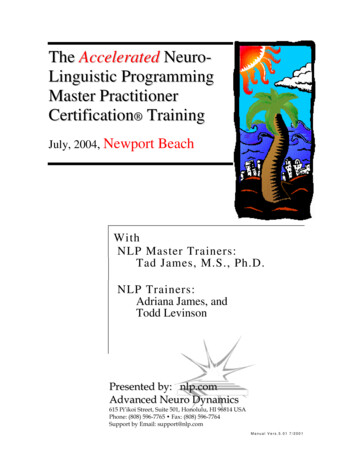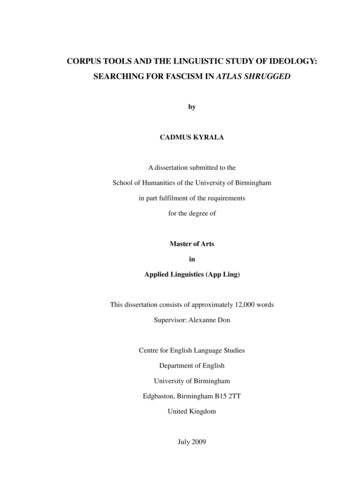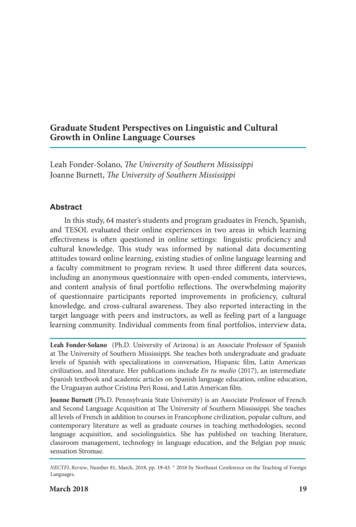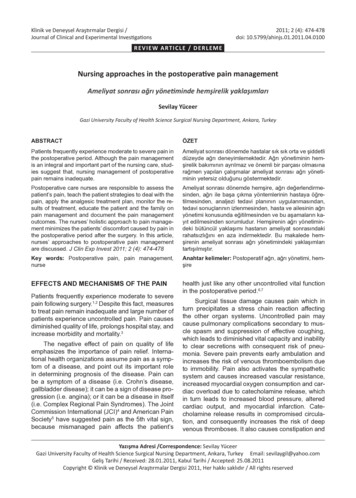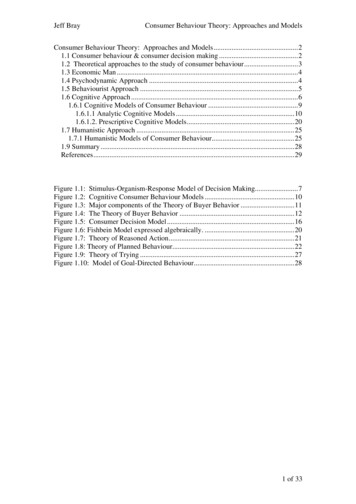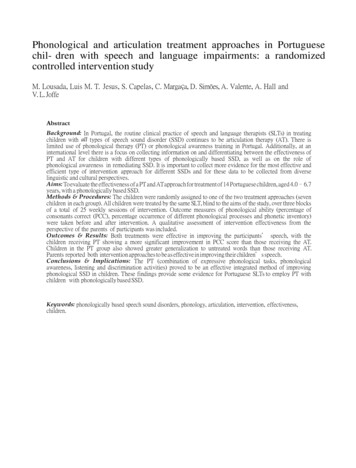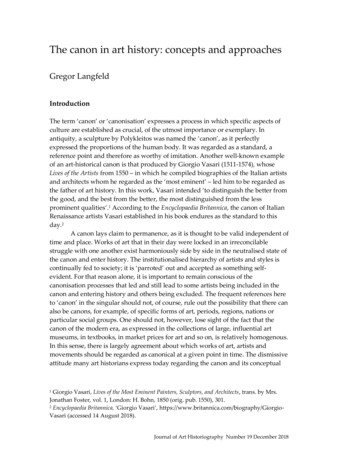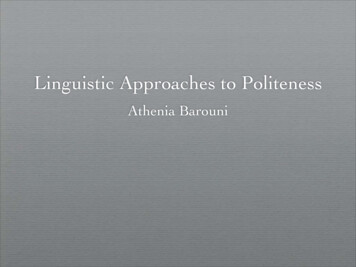
Transcription
Linguistic Approaches to PolitenessAthenia Barouni
What do we want to know?! How do you use language to be polite? How polite are you actually being?
What has been done? Linguistic strategies described from Brownand Levinson (1987)Concrete attempt to apply these strategies inreal linguistic data (Danescu-Niculescu-Mizilet al. 2013)Expressions of “courtesy” and“politeness” (Jucker, Taavitsainen, Schneider2012)
What matters when looking atpoliteness? Strategies used to manipulate context. (hedging,seeking agreement, identity markers)Level: Discourse level- relationships betweenutterance.Utterance level-how a form is usedstrategically in order to achieve the speaker’sgoal (incurring a debt) very specific
Terminology Negative Politeness- Presume that the speaker will be imposing on thelistener and there is a higher potential for awkwardness orembarrassment. ex. be indirect, use hedges, minimize imposition,apologizePositive Politeness- Makes the hearer feel good about themselves,interests, or possessions. (usually audience are familiar to oneanother) ex. be optimistic, inclusive, use in group markers, jokeNegative Face- is the need to be independent, to have freedom ofaction, and not to be imposed on by others.Positive Face- the need for self-image to be accepted,appreciated and approved of by others. To be treatedas a member of the same group and to know that hiswants are shared by others.
Face Saving Acts Oriented towards negative or positive faceFace saving towards negative face will tend toshow deference, emphasize the importance ofthe other’s time or concerns, and even includean apology for the imposition or interruption.A face saving act towards positive face willshow solidarity, emphasize that both speakerswant the same thing, and that they have acommon goal.
Face Threatening Acts An act that inherently damages the face of the addresseeor the speaker by acting in opposition to the wants anddesires of the other. ex. orders, requests, advice, threats,warnings. effects both negative and positive face negative ex: making a request positive ex: saying no or disagreeing!!
Negative Content Specific and focused, it performs the functionof minimizing impositionCan have it towards negative and positive faceExample: I’m sorry it’s a lot to ask, but canyou lend me a thousand dollars?
Positive Content Strategy to minimize the threat to the hearer’spositive faceUsed to make the hearer feel good aboutthemselves or their interests.Example: You look so sad. Is there anything Ican do?Addressing negative face: ex. I know I can trustyou to input the data in the computer quickly.
Strategies(Brown and Levinson 1987)
HedgeAvoid DisagreementPessimisticIn group identity markersIncurring DebtGive DeferenceDon’t impersonalizespeaker or hearerPolitenessPresuppose/raise/assert common groundMinimize ImpositionNominalizeGive or ask for reasonsSeek agreement
In group Identity Markers Examples: Help me with this bag here, will you pal? Come here, honey Address forms: Mac, mate, buddy, pal, honey, dear, duckie, luv, babe, Mom,blondie, brother, sister, cutie, sweetheart, guys, fellas. Semantic class of positive address forms Claim common ground
Presuppose/Raise/AssertCommon Ground Examples: Ok let's stop the chatter and get on with our essays. Now, have we taken our medicine? (doctor to patient) Inclusive we
Don’t Impersonalize Speaker and Hearer Example: You come here or hey youAvoid 'you'Address terms as ‘you’ avoidance. note the rudeness of ‘you’ as an address form ina hail or attention getting phrase. [using “you” seems rude, especially as directaddress]
Minimize the Imposition Examples: I just want to ask you if (I can borrow/you can lend me) a (tiny bit of/little/single sheet of) paper. I just dropped by for a minute to ask if you. Modified verb with request followed by if semantic class of something ‘small’ of whatever you want
Seek agreement Examples: A: I had a flat tire this morning. B: Oh god, a flat tire! A: John went to London this weekend. B: To London! Helps demonstrate you heard correctly and used to stress emotional agreementwith the utterance (stress interest and surprise)Repetition
Hedge Word or phrase that modifies the degree of membership of a predicate or nounphrase in a set; it says of that membership that is partial or true only in certainrespects or that it is more true and complete than perhaps might be expected.
Hedge Softens a command Close the window, (if you can/if you want)
Quality hedges Example: To the best of my recollection.I think.I believe.I assume. Speaker is not taking full responsibility for the truth of his utterance. Main clause with hedge verb (mental state verbs) Polite, reluctant
Avoid disagreement Examples: I really sort of (think, hope, wonder). I kind of want Florin to win the race, since I bet on him. Hedging opinions speaker is vague about opinions so as not to disagree. Sort of, kind of, like
Incurring a Debt Example: [I’d be eternally grateful] if you would. [I’ll never be able to repay you] if you. Embedded request with an “if”
Pessimistic Examples: You couldn’t possibly/by any chance lend me your lawnmower (Could/would/might) you do X? vs. (Can/Will/May) you do X? Tag question do you? isn’t it? at end. in the context of an utterance. Expressing doubt in the form of a yes or no question.
Give or ask for reasons Example: Why not lend me your cottage for the weekend? Why don’t we go to the beach! For speaker to give reasons as to why he wants what he wants. Implying “I canhelp you” or “you can help me” and assuming cooperation a way of showing whathelp is needed.
Give deference Examples: Excuse me, but. (I hope you’ll/Please/Would you) forgive me if. Followed by if or but Beg forgiveness. social formulas for begging forgiveness, recognizable as sociallyacceptable.
Nominalize Example: I am surprised that you failed to reply. I am surprised at (you/your) failing to reply I am surprised at your failure to reply Not only subjects and predicates but complements as well have such degrees offormality corresponding to degrees of nouniness
Automatic attempts toidentify politeness
Expressions of “courtesy” and “politeness”(Jucker,Taavitsainen, Schneider 2012) Used Helsinki Corpus collection. Explains how politeness changed through time Handpicked keywords not as sophisticated asDanescu-Niculescu-Mizil et al.Some examples of words: courtship, debonair,gracious, and fairly
A Computational Approach to Politeness(Danescu-Niculescu-Mizil et al. 2013) Key components of polite theory indirection,deference, impersonalization and modality.Studied relationship between politeness andsocial power Computational framework focused on requests Corpus: Wikipedia and Stack Exchange
A Computational Approach to Politeness Labeled request data using AmazonMechanical Turk (AMT)Study revealed new interactions betweenpoliteness marking and positioning ofkeywords in context.
Top Polite Strategies(Danescu-Niculescu-Mizil et al.)StrategyExamplesGratitudeI really appreciate that you’vedone themDeferenceNice work so far on yourrewrite.Indirect (btw)By the way, where did youfind.Please (not start)Could you please say more.ApologizingSorry to bother you.Counterfactual modalCould/Would you.
Top Rude Strategies(Danescu-Niculescu-Mizil et al.)StrategyExamplesDirect startSo can you retrieve it or not?FactualityIn fact you did link.2nd person startYou’ve reverted yourself.Please startPlease do not removewarnings.Direct questionWhat is your native language?Negative lexiconIf you’re going to accuse me.
Similar Strategies of Danescu andLevinsonName of LevinsonStrategy!Language markerDanescue equivalences!!give deferencefollowed by if or but apologizingbe pessimisticwould/couldcounterfactual modalbe pessimisticcan/will/mayindicative modalpresuppose/raise/assert commongroundinclusive we1st pluralquestion, hedgemain clause w/hedge hedgeverb
References Brown, Penelope and Stephen C. Levinson. 1987. Politeness: Some universals inlanguage usage. Cambridge: Cambridge University Press.Danescu-Niculescu-Mizil, Cristian, Sudhof Moritz, Dan Jurafsky, and JureLeskovec. A computational approach to politeness with application to social factors. Web. http://www.stanford.edu/ jurafsky/pubs/politeness-acl13.pdf .Knapp, Mark . The SAGE Handbook of Interpersonal Communication. 4th . Austin:SAGE Publications, Inc , 2011. 800. Print.Jucker, Andreas, Irma Taavitsainen, and Gerold Schneider. "Semantic corpustrawling: Expressions of “courtesy” and “politeness” in the Helsinki Corpus."Varieng. N.p., 05 10 2012. Web. 7 Nov 2013. ucker taavitsainen schneider/
Extras
5 politeness super strategies 1. State news baldly with no politeness ex. You did not get the part. 2. Display positive politeness ex. You’re a great actress, but you didn’t get thepart.3. Display negative politenessex. I know you gave it your all in the audition. Itwas a tough decision, I may be making a bigmistake, but you didn’t get the part.
5 politeness super strategies 4. Stating news off the record by violating aconversational maximex. Perhaps a different role would be bettersuited for you.5. Withholding the news entirely(ostensibly)ex. I haven’t made the decision yet.Knapp & Daly (2011)
Face saving towards negative face will tend to show deference, emphasize the importance of the other’s time or concerns, and even include an apology for the imposition or interruption. ! A face saving act towards positive face will show solidarity, emphasize that both speakers want the same thing, and that they have a common goal. Face Threatening Acts An act that inherently damages the face .
